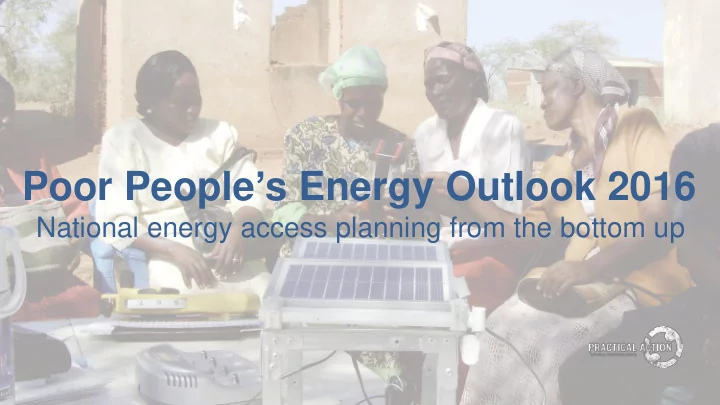

Poor People ’ s Energy Outlook 2016 National energy access planning from the bottom up
Total Energy Access
Energy poverty is set to increase
Energy plans suffer from a know your customer deficit
A people centered approach
Bangladesh Kenya Togo
Community energy planning • Mapped resources and technically feasible solutions • Current levels of access (multi-tier framework) • Needs and priorities in home, work, community • Modelled least-cost means of delivering that level of energy demand • Gender focus: different needs and opportunities for men and women
Scale of the challenge Affordability Low level Unsafe and Access of supply cooking • The spread of small-scale solar is impressive, used by over 60% of • Those with an electricity supply were mostly in Tier 1 (or Tier 0) • Reliance on biomass fuels (mostly wood) on very basic stoves • Over 92% in every case wanted energy services requiring at least Tier 2, • Very few manufactured stoves (1 in Bangladesh, 8 in Togo) households in 5 of 12 communities • Huge time invested in collecting and preparing fuel, and cooking • But there is an income gap. Those without are on average poorer often more for SMEs • In some communities and countries (e.g. Togo) solar markets remain thin
Needs and priorities Priority Bangladesh Kenya Togo 1 st Households Households Households 2 nd Agriculture / Schools Street lighting Business needs 3 rd Schools / Schools Businesses Street lighting
Least- cost solutions: integrated rural energy access plans Small enterprises Dispersed households Support the economics Best served by In 11 out of 12 stand-alone systems. of mini-grids. Tier 2 or 3 biomass communities, mini- Clean cooking Water pumping Brings massive health Significantly lightens solutions cheaper grids or stand-alone Needs in small-holder women’s work. benefits. than current cooking. solutions were agriculture and post- Enthusiasm for clean cheaper or cost- harvest. fuel solutions, but competitive with grid Varying levels of these are more extension existing SME activity. expensive On average a quarter of electricity demand. Community facilities: schools, Clustered households Farm appliances street lighting and health clinics Most economically Consistently highly prioritized by Reduces the manual communities. served by mini-grids. agro processing burden.
Calls to action
Promote integrated planning Re-prioritize cooking Recognize differentiated needs Measure what’s meaningful
Major obstacles, simple solutions Capacity-building on decentralized energy technologies Voice of energy-poor in planning
What’s next? PPEO 2016 – Planning PPEO 2017 – Financing PPEO 2018 – Implementing
Thank you!
policy.practicalaction.org/PPEO2016 #PPEO16 @PracticalAction ppeo@practicalaction.org.uk
Recommend
More recommend